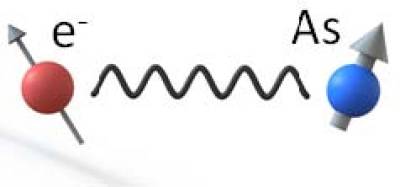The elementary unit of quantum information is the quantum bit or qubit. Like the classical bit, the qubit is a two-level system but with the intriguing ability to exist in a superposition of states. This means it can be in the on and off state at the same time which has profound implications if we consider quantum systems of more than one qubit. Instead of each qubit carrying any well-defined information of its own, the information is encoded in their joint properties. In quantum mechanics, the qubits are described as being entangled. The challenge is to find ways to harness quantum phenomena such as superposition and entanglement to construct a quantum computer that is able to perform tasks that are unaittainable in a classical context.
A very natural qubit is the electron spin. The energy difference between spin states of an electron can be precisely controlled by magnetic fields and, using the electron's charge, it is also possible to isolate and manipulate individual spins electrically. One route to achieve entanglement between spin qubits is to use the interaction of their wavefunction overlap by placing them in close proximity [1]. While such an approach is feasible for a small number of qubits, a large-scale quantum processor which relies on direct nearest neighbour coupling becomes rapidly impractical. In our group we therefore follow an alternative strategy which makes use of an intriguing quantum mechanical effect by which two spatially separated quantum bits become entangled if a measurement cannot tell them apart.
As has been shown theoretically, measurement-based entanglement can be used to couple large numbers of physically separated qubits, building up so-called graph states. Computation is then achieved by a sequence of measurements on individual qubits that consumes the entanglement - known as one-way quantum computation - which is entirely different from the standard circuit-based approach [3]. In practise this also requires the presence of a quantum memory where quantum information is stored to allow graph-state growth without the risk of losing existing entanglement. In our group we use a solid-state implementation which is ideally suited to this task: single As-dopants in isotopically pure Si-28.

The devices are fabricated by the group of Prof. Neil Curson and Dr. Taylor Stock at the LCN using the most precise silicon dopant incorporation technique available: scanning tunnelling microscopy (STM) hydrogen resist lithography [3]. The atomically precise incorporation of individual As-dopants is essential in satisfying a key requirement of the measurement-based entanglement protocol: qubit indistinguishability. To manipulate the electron spins of the As-dopants and create entanglement between remote qubits using projective measurements we exploit radio-frequency reflectometry techniques which allows us to perform these tasks on a timescale significantly faster than electron spin lifetimes. We furthermore aim to use hyperfine coupling to transfer the quantum information from the electron to the As nuclear spin states. This approach takes advantage of record nuclear spin coherence, in the 10-100 second range, of dopants in Si and allows us to grow the entangled spin qubit network. This work is in collaboration with VTT, Finland and Zurich Instruments, Switzerland and the group of Prof. Sougato Bose at UCL who is working on the theory of measurement-based entanglement of donor spin qubits.
| [1] Loss and Divincenzo, Physical Review A 57, 120 (1998) | [2] Briegel et al, Nature Physics 5, 19 (2009) | [3] Stock et al, ACS Nano 14, 3316 (2020) |
 Close
Close

